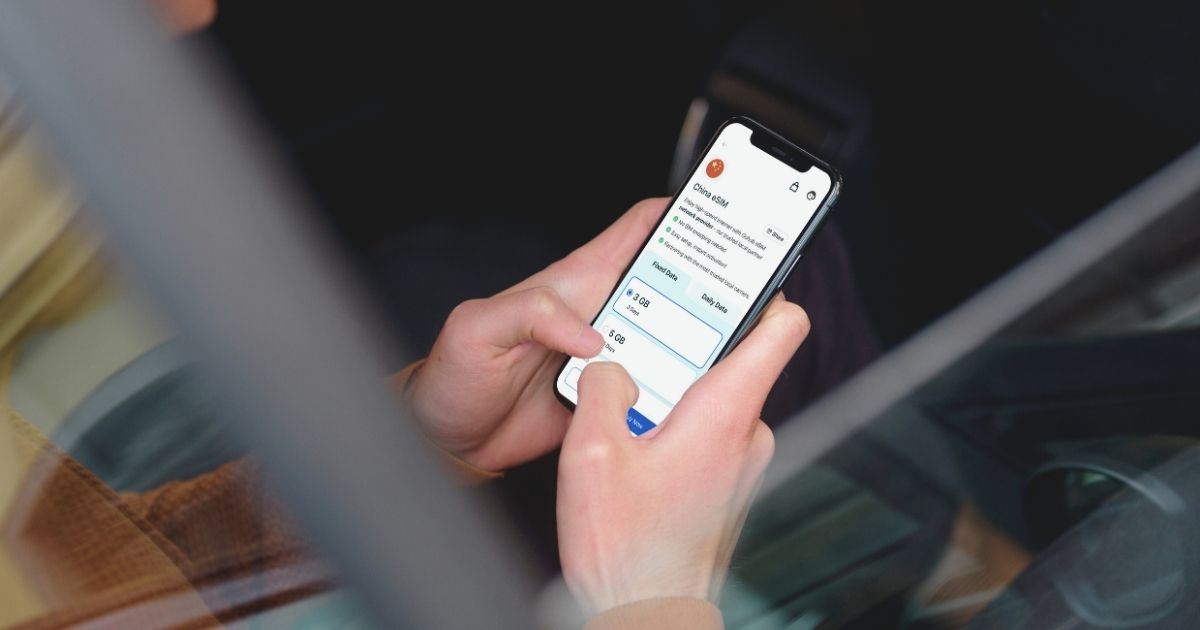As a digital nomad, your ability to stay connected across borders is non-negotiable. Yet many nomads overlook a critical component of modern mobile connectivity: the EID number that powers your device’s eSIM functionality.
Understanding your device’s EID number has become increasingly important as more digital nomads transition from physical SIM cards to the flexibility of eSIM technology. This unique identifier is your gateway to seamless connectivity as you move between countries and networks.
In this comprehensive guide, Nomada will explain everything you need to know about EID numbers, why they matter for location-independent professionals, and how to find and use yours for stress-free global connectivity.
Understanding EID numbers: the digital nomad’s connectivity foundation

The EID number (Embedded Identity Document) serves as the unique identifier for your device’s eSIM capabilities, essentially functioning as the digital equivalent of the ICCID number on physical SIM cards.
What exactly is an EID number?
An EID number is a 32-digit unique identifier embedded in your device’s hardware that allows mobile carriers to authenticate and provision eSIM profiles remotely. Unlike physical SIM cards, which can be swapped or lost, the EID is permanently associated with your device and serves as its digital passport to mobile networks worldwide.
The EID contains information about your device’s manufacturer, model, and unique identifiers that allow carriers to securely provision service. For digital nomads, this means the ability to activate local data plans remotely without hunting for physical SIM cards in each new destination.
🌟 Pro tip: before departing for a new destination, verify your device’s EID number and compatibility with local carriers to ensure you can activate an eSIM upon arrival, saving precious time during your transition.
How EID numbers differ from IMEI and ICCID
While your device has several identifying numbers, the EID number serves a specific purpose in the eSIM ecosystem. Unlike the IMEI (International Mobile Equipment Identity) which identifies your physical device for security and warranty purposes, the EID specifically enables eSIM functionality.
ICCID numbers are associated with physical SIM cards, while EID numbers are permanently embedded in your device’s hardware. For digital nomads, this distinction is crucial—your EID never changes, allowing you to manage multiple eSIM profiles from different carriers simultaneously without physically swapping cards.
💡 Did you know? The EID number standard was developed by the GSMA (the global association of mobile network operators) to create a secure, universal system for eSIM authentication that works across borders and carriers.
Why EID numbers are essential for digital nomads

For location-independent professionals, the EID number represents much more than a technical specification—it’s the foundation of flexible, reliable connectivity that modern nomadic work demands.
Seamless country transitions
The primary advantage of understanding your EID number is the ability to pre-arrange connectivity before arriving in a new country. Instead of searching for local SIM cards upon arrival (often while jet-lagged and unfamiliar with the local language), digital nomads can use their EID to activate eSIM profiles remotely.
This capability transforms the first 24 hours in a new destination from a connectivity scramble into productive time. You can land with functional data service, immediately access maps, translation services, and work communications without delay or the stress of finding a local mobile shop.
Managing multiple network profiles
Digital nomads frequently return to previous destinations or maintain ongoing projects across multiple countries. Your device’s EID number enables you to store multiple eSIM profiles simultaneously and switch between them as needed.
This multi-profile capability allows you to maintain a home country number for client calls while using local data in your current location. You can also keep profiles from frequently visited countries stored on your device, reactivating them instantly upon return rather than starting the SIM acquisition process from scratch.
🌟 Pro tip: create a digital document listing your device’s EID number and all active eSIM profiles with their associated phone numbers and data allowances. This reference guide becomes invaluable when troubleshooting connectivity issues while traveling.
Enhanced security for location-independent professionals
Using your device’s EID number with eSIM technology provides security advantages that physical SIMs can’t match. Since the embedded identifier can’t be physically removed from your device, the risk of SIM theft or cloning is virtually eliminated.
For digital nomads who often work with sensitive client information or financial data, this added security layer helps maintain professional standards regardless of location. Additionally, remote eSIM provisioning means fewer interactions with unknown local vendors, reducing opportunities for potential security breaches.
How to find your device’s EID number

Locating your EID number is straightforward on most modern devices, though the exact process varies by operating system and manufacturer.
Finding EID number on iOS devices
Apple was among the first manufacturers to embrace eSIM technology, making the EID number relatively easy to locate on iPhones and iPads:
- Open the Settings app on your iOS device
- Tap “General” and then “About”
- Scroll down until you see “EID” – the 32-digit number displayed is your device’s embedded identifier
- You can copy this number by tapping and holding on it
Many digital nomads find it helpful to maintain reliable connectivity while searching for their device information. A travel-focused eSIM solution from Holafly ensures you have data access to research carrier requirements and activate new profiles using your EID number, even when traveling through remote locations.
Locating EID number on Android devices
Android devices have varying methods to access the EID number depending on the manufacturer and model:
For Samsung Galaxy devices:
- Navigate to Settings > Connections > SIM Card Manager > eSIM Card Manager > eSIM Info
- Your EID will be displayed as a 32-digit number
For Google Pixel devices:
- Go to Settings > Network & Internet > SIMs > eSIM
- Tap on “eSIM details” to view your EID
For other Android devices:
- Check Settings > About Phone > Status > SIM Status > EID
- Alternatively, dial *#06# on your phone’s keypad and look for the EID in the displayed information
Key considerations for finding your EID number:
- Your device must be eSIM compatible
- Some older device models may require firmware updates
- Not all budget smartphones support eSIM technology
- Business-class devices typically have better eSIM support
- Carrier-locked devices may have restricted eSIM functionality
- Always check manufacturer documentation for specific instructions
🌟 Pro tip: take a screenshot of your EID number or store it in a secure password manager. Having this information readily available saves time when activating new eSIM profiles in different countries.
Using your EID number as a digital nomad

Once you’ve located your device’s EID number, you can leverage it to create a seamless connectivity experience that supports your location-independent lifestyle.
Activating eSIMs with your EID number
The process of activating an eSIM using your EID number typically follows these steps:
- Purchase an eSIM plan from a provider (either online or in person)
- Provide your EID number to the carrier or enter it in their activation portal
- Receive a QR code or activation code from the provider
- Scan the QR code with your device’s camera or enter the activation code
- Follow the on-screen instructions to download and install the eSIM profile
- Set your preferences for the new profile (data only, voice and data, etc.)
- Activate the profile when ready to use it
The entire process can often be completed in minutes, giving you immediate connectivity without waiting for physical SIM delivery or visiting a store.
Managing multiple eSIM profiles

The true power of understanding your EID number comes from effectively managing multiple connectivity profiles across different carriers and countries.
Most modern smartphones allow you to store several eSIM profiles simultaneously and switch between them as needed. For example, you might maintain:
- A home country profile for receiving verification codes and client calls
- A data-only profile for your current location
- Backup profiles for upcoming destinations
This flexibility eliminates the need to physically swap SIM cards or maintain multiple devices, streamlining your digital nomad setup while ensuring you’re always connected regardless of location.
Final thoughts on EID numbers for digital nomads
Your device’s EID number may seem like a minor technical detail, but for location-independent professionals, it represents the foundation of reliable global connectivity. Understanding and utilizing this unique identifier transforms how you maintain communication networks while living and working across borders.
As eSIM technology continues to evolve and expand to more regions, the importance of your EID number will only increase. Forward-thinking digital nomads are already leveraging this technology to eliminate connectivity gaps between destinations and reduce dependence on physical SIM cards.
Whether you’re new to the nomadic lifestyle or a seasoned remote professional, mastering eSIM technology through your EID is an essential skill in today’s borderless work environment.
Looking to streamline all aspects of your digital nomad lifestyle?
Explore our comprehensive guides for location-independent professionals for everything from connectivity solutions to remote work productivity strategies.
Your borderless lifestyle deserves seamless connectivity—discover it with Nomada 👉
Frequently asked questions about EID numbers
Most premium smartphones and tablets released after 2018 include eSIM functionality and an EID number. This includes iPhone XS and newer, Google Pixel 3 and newer, Samsung Galaxy S20 and newer, and select iPad models. Check your device manufacturer’s specifications to confirm compatibility.
No, the EID number is permanently embedded in your device’s hardware during manufacturing. It functions like a digital fingerprint and cannot be modified, which is what makes it secure for eSIM authentication purposes.
While some eSIM providers don’t explicitly request your EID number (using QR codes instead), having it readily available streamlines troubleshooting and account management. It’s particularly useful when working with customer support to resolve connectivity issues.
Yes, sharing your EID number with legitimate mobile carriers is safe and necessary for eSIM activation. However, like other device identifiers, only share it with trusted service providers and never post it publicly online.
Absolutely. Your single EID number supports multiple eSIM profiles on your device. This is precisely what makes it valuable for digital nomads who need connectivity across various countries and carriers.




